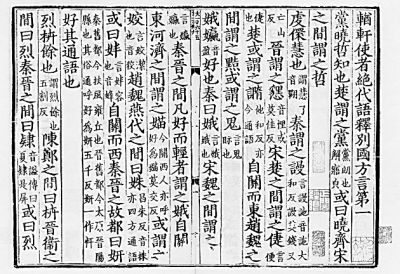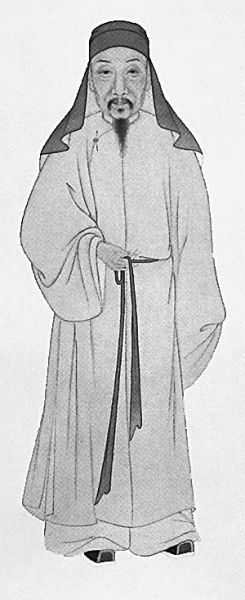China ancient linguistics has its own development path.


[Chinese written talk]
In many years of teaching, I deeply feel that the study of ancient linguistics in China has a long history and rich heritage, and there are linguists and linguistic monographs in previous dynasties, so we should learn, inherit and carry forward it.
Due to years of insufficient attention, insufficient study and research, and insufficient publicity on foreign comments, China linguistics was rarely found in the works of linguistic history of western linguists. The reason is that, on the one hand, they know little about China’s ancient linguistics because of the writing barrier; On the other hand, they regard Indo-European languages as the main language, and think that language science was established in the 19th century, because there was historical comparative linguistics in Europe at that time, which resulted in general linguistics. They think that the language research before this, especially the language research of the oriental nationalities, is the so-called "pre-science" language research, or it is called "Philology", but it can’t be called "Linguistics". This theory influenced Chinese linguistics at that time. However, the statement that China’s ancient linguistics is unscientific philology is not in line with the reality of China’s ancient linguistics.
China’s ancient linguistics has a long history and brilliant achievements, which are not inferior to those in the world linguistics. Some of the research results are outstanding, such as Yang Xiong in the Western Han Dynasty (206 BC-23 AD), who completed the world’s first book "Dialect" to investigate and study spoken dialects around the world in 27 years. He scientifically analyzed dialects, lingua franca, ancient and modern languages and their relations, and recorded the distribution of dialects in Han Dynasty, which is of great value. Guo Pu’s Preface to Dialects called it "a wonderful book that is true and consistent, and it is also a record if it is not published". Another example is Xu Shen’s Shuo Wen Jie Zi in the Eastern Han Dynasty (AD 25-AD 220), which is the first linguistic monograph to systematically explain and interpret characters. Shuowen Jiezi analyzes the structural rules of Chinese characters and created the radical. It has been two thousand years since then, and we are still using the radical he created in the dictionary. A work that spans two thousand years still has vitality, which is rare in the history of world linguistics.
Chinese ancient linguistics has its own development path only because of the different social development and language characteristics. Ancient Chinese linguists studied Chinese characters and analyzed some objective laws of Chinese characters. Linguistic research rose gradually in the Qin and Han Dynasties, with Erya and Dialect by Yang Xiong in the Western Han Dynasty, Xu Shen’s Shuowen Jiezi and Liu Xi’s Interpretation of Names in the Eastern Han Dynasty, which led to the rise of ancient "exegetics" and "philology". At the end of Han Dynasty, in Wei and Jin Dynasties, under the influence of Buddhism and Sanskrit, linguists were able to connect with the reality of Chinese, make a comparative study, and creatively analyze and study the sound, rhyme and tone system of Chinese, which led to the rise of ancient "phonology". It can be said that the achievements of linguistics in Han dynasty marked the establishment of ancient Chinese language science.
China ancient linguistics, its research results can be self-contained, and has its own characteristics. Now I just want to talk about my experience with his research methods.
First, China’s ancient linguistics is connected with practice.
The rise and establishment of ancient linguistics in China in the Han Dynasty, and the rise of exegetics and philology were closely related to the development of Chinese and society at that time. In the pre-Qin period, the characters were abnormal and the language was abnormal. After the reunification of Qin Shihuang, the "writing in the same language" was implemented, which explained the complexity of the language at that time. In the Han dynasty, this situation was first manifested in the dispute between "Jing" and modern ancient prose. After the reunification of the Han Dynasty, the cultural and ideological measures mainly include: respecting Confucianism alone, mobilizing folk books, and establishing doctors of the Five Classics. Five Confucian classics, The Book of Songs, Shangshu, Yijing, Book of Rites and Chunqiu, were collected in the Han Dynasty. Confucian classics, after Qin fire, were mostly burned and lost. At the beginning of the Han Dynasty, some Confucian scholars had to dictate it and record it in the official script at that time, which is the "Jinwenjing". The "Ancient Classics" refers to the Confucian classics written in Da Zhuan or Shu Shu in the pre-Qin period, which were found from time to time due to the encouragement of the imperial court to present books.
At first, the problem of "Jing" in ancient Chinese refers to the different fonts of Jing books. Later, Dong Zhongshu founded the study of Confucian classics, established himself as a scholar and served the court. However, Wei Hong, Jia Kui, Ma Rong and Zheng Xuanduo, scholars of ancient Chinese classics, made notes on the classics from the aspects of writing, exegetics and the system of famous things, forming two schools. The Han Dynasty advocated Confucian classics, and there were more than 3,000 doctoral disciples when Han became emperor. At that time, the emperor wrote a letter, and the officials and the people all quoted scriptures. Confucianism is combined with official career, therefore, not only the imperial court but also the local government should run schools, thus promoting the study of language and writing more widely. Erya, the first linguistic monograph in ancient China, was gradually compiled by many Confucian scholars because of the prosperity of Confucian classics in Han Dynasty and the need of serving Confucian scholars (scholars in Han Dynasty) to interpret Confucian classics. Erya is a compilation of exegesis. Another example is that Jia Kui, a scholar of classical Chinese classics, was Xu Shen’s teacher, and Xu Shen’s Shuo Wen Jie Zi was influenced by it, which was related to advocating Confucian classics in the Han Dynasty.
In a word, the language study in the Han Dynasty was linked with reality, with the reality of social development at that time and with the reality of Chinese characters at that time, which led to the rise of exegetics and philology and marked the establishment of ancient language science in China.
Secondly, the study of ancient linguistics in China is good at inheriting and developing.
The reason why human culture is developing continuously is that it is good at inheriting and developing. For example, Xu Shen said in the Preface to Explaining Words: "Learn from others." Before he wrote Shuowen, there were many word books, such as Cang Xie by Li Si, Jijiu by Shi You, etc., which had collected more than 5,000 words successively, as well as Erya and Dialect. Xu Shen’s Shuo Wen Jie Zi has increased its income on the basis of predecessors, with a total of 9,353 words. He not only increased the number of Chinese characters, but also further explained the shape, sound and meaning of Chinese characters, analyzed and summarized the structural rules of Chinese characters, and initiated the "radical", which was a creative inheritance and development. Duan Yucai called it "an unprecedented book, which was originally created by Xu Jun" in his annotation "The Preface of Explaining Words". Shuowen is the first linguistic monograph that systematically explains characters, and it is a linguistic monograph that laid the foundation for linguistics in Han Dynasty and has great influence on later linguistic research.
Linguistics in Qing Dynasty is outstanding in inheritance and development. Erya, Dialect, Shuo Wen Jie Zi and Shi Ming of Han Dynasty spread to Qing Dynasty. Due to a long time, some articles were corrupted and many annotations fell off, which was sorted out by Qing Confucianism and further textual research was carried forward.
Thirdly, China’s ancient linguistic research methods were scientific and rigorous.
Since the Han Dynasty, the research methods of ancient linguistics in China have been rigorous and scientific. For example, Yang Xiong can analyze dialects, lingua franca, ancient and modern languages and their relations with the progressive viewpoint of taking spoken dialects as the research object and the scientific method of field investigation, and can record the general situation of dialect distribution in Han Dynasty. When he was seventy years old (AD 17), Liu Xin, then a Buddhist of Wang Mang, wrote to him asking for this book. In Answer to Liu Xin’s Book, Yang Xiong described the motivation and process of writing this book, and explained that it was inconvenient to show people because the whole book was undecided. If Liu Xin threatens him to hand over this book, he will "hang himself to do it", which shows his rigor and love for his life-long meticulous work. Another example is Xu Shen’s Shuo Wen Jie Zi, which illustrates the relationship among form, meaning and sound. It is an important method to study ancient language and characters by the research method of mutual communication among the three.
China’s linguistics developed to the Qing Dynasty, with Gu Yanwu at the beginning, and talented people came forth in large numbers. Gu Yanwu’s research methods: First, he attached great importance to first-hand information; Second, solicit evidence. When he studied ancient phonology, he first paid attention to the rhyme of the Book of Songs in the pre-Qin period and the first-hand materials of other rhymes. It is also verified from the aspects of harmonic sound, different pronunciation, phonological training and dialect. For example, in order to prove the word "xing", he only had the sound of "hang" in ancient times, and there were as many as 372 materials. Gu Yanwu initiated a generation of study style, Dai Zhen, Duan Yucai, Wang Niansun and other theoretical understandings are relatively advanced, and the research methods are relatively scientific, especially the excellent study style of discussing academic issues on an equal footing and convincing others by reasoning is worth learning.
China’s ancient linguistics is an important part of our motherland’s cultural treasure-house. It is precisely because ancient linguists are good at connecting with reality, inheriting and developing, and adopting scientific methods. These advantages are still worthy of our serious study. I hope young scholars and graduate students can further study ancient linguistics and carry it forward.
(The author is a professor of Chinese Department of Fudan University at the age of 94.)